Employability Skills Report: NHS Organization Management Analysis
VerifiedAdded on 2020/06/03
|16
|4312
|45
Report
AI Summary
This report examines essential employability skills within the National Health Service (NHS) organization. The report delves into various aspects, including the responsibilities of different roles like board members, managers, and doctors, highlighting the importance of effective performance objectives and evaluation. It explores the significance of training and continuous improvement within the organization, along with the impact of motivational techniques on enhancing the quality of performance. Furthermore, the report addresses problem-solving strategies, emphasizing the need for clear communication and effective time management. The analysis covers communication styles, the role of technology, and the importance of language proficiency. Overall, the report provides insights into how these skills contribute to the success and efficiency of the NHS.
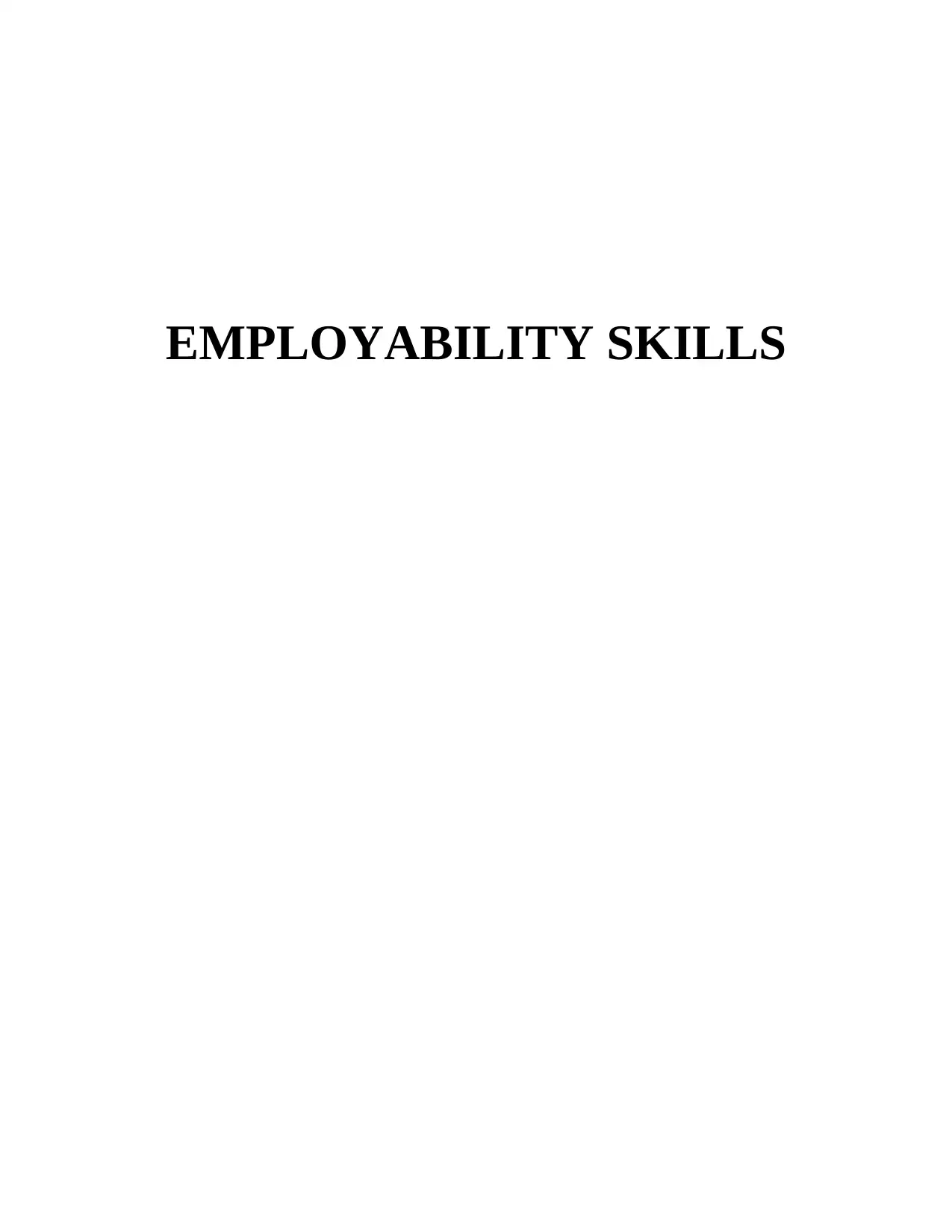
EMPLOYABILITY SKILLS
Paraphrase This Document
Need a fresh take? Get an instant paraphrase of this document with our AI Paraphraser
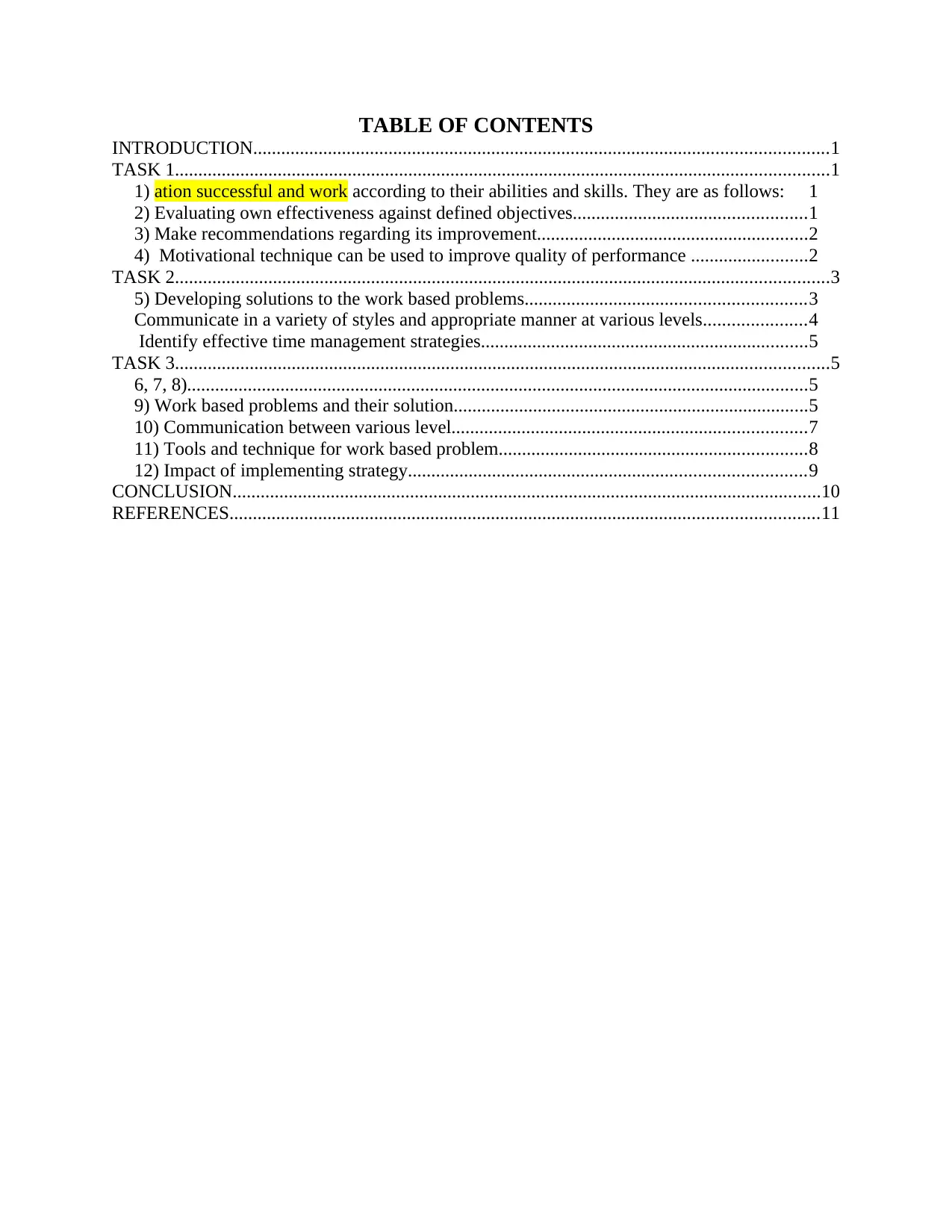
TABLE OF CONTENTS
INTRODUCTION...........................................................................................................................1
TASK 1............................................................................................................................................1
1) ation successful and work according to their abilities and skills. They are as follows: 1
2) Evaluating own effectiveness against defined objectives..................................................1
3) Make recommendations regarding its improvement..........................................................2
4) Motivational technique can be used to improve quality of performance .........................2
TASK 2............................................................................................................................................3
5) Developing solutions to the work based problems............................................................3
Communicate in a variety of styles and appropriate manner at various levels......................4
Identify effective time management strategies......................................................................5
TASK 3............................................................................................................................................5
6, 7, 8).....................................................................................................................................5
9) Work based problems and their solution............................................................................5
10) Communication between various level............................................................................7
11) Tools and technique for work based problem..................................................................8
12) Impact of implementing strategy.....................................................................................9
CONCLUSION..............................................................................................................................10
REFERENCES..............................................................................................................................11
INTRODUCTION...........................................................................................................................1
TASK 1............................................................................................................................................1
1) ation successful and work according to their abilities and skills. They are as follows: 1
2) Evaluating own effectiveness against defined objectives..................................................1
3) Make recommendations regarding its improvement..........................................................2
4) Motivational technique can be used to improve quality of performance .........................2
TASK 2............................................................................................................................................3
5) Developing solutions to the work based problems............................................................3
Communicate in a variety of styles and appropriate manner at various levels......................4
Identify effective time management strategies......................................................................5
TASK 3............................................................................................................................................5
6, 7, 8).....................................................................................................................................5
9) Work based problems and their solution............................................................................5
10) Communication between various level............................................................................7
11) Tools and technique for work based problem..................................................................8
12) Impact of implementing strategy.....................................................................................9
CONCLUSION..............................................................................................................................10
REFERENCES..............................................................................................................................11
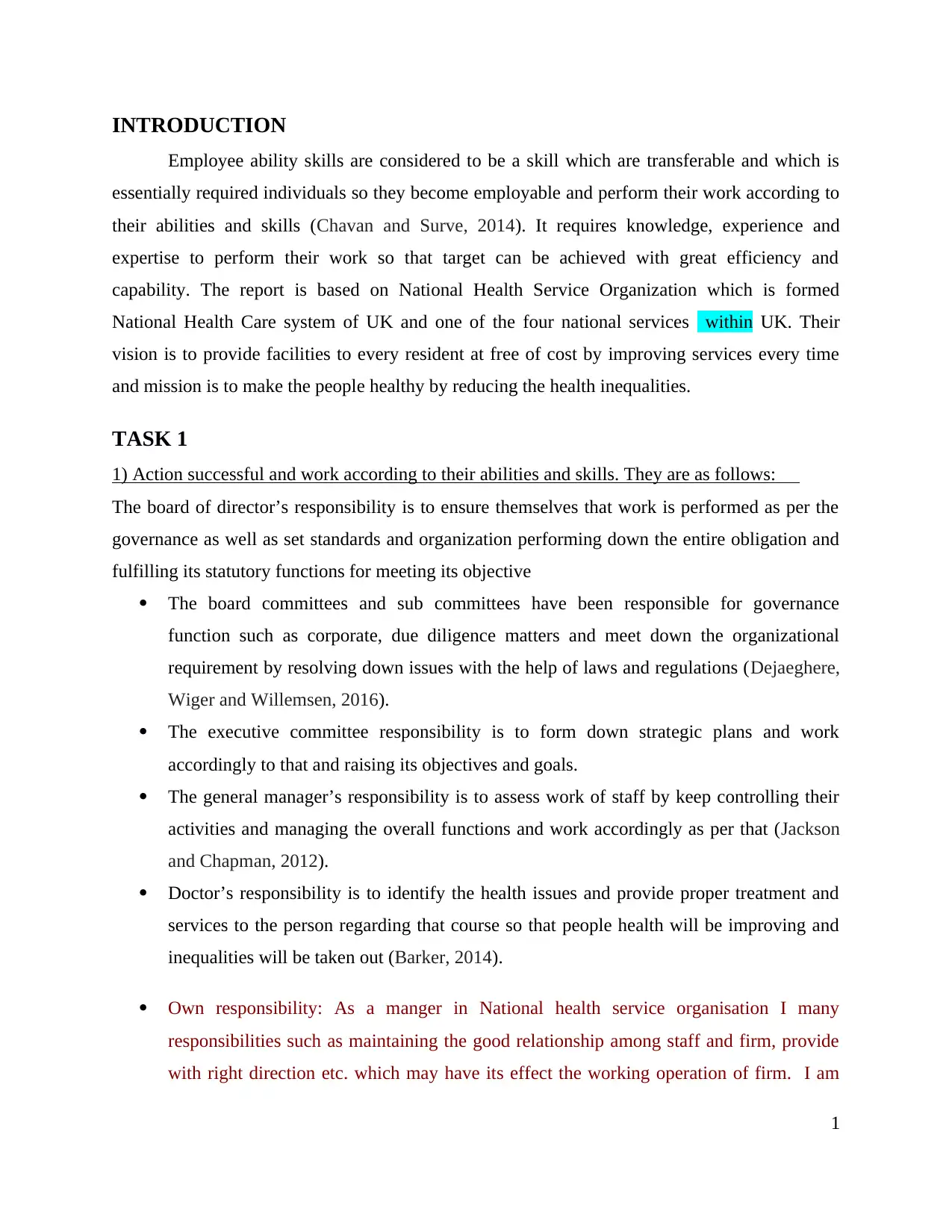
INTRODUCTION
Employee ability skills are considered to be a skill which are transferable and which is
essentially required individuals so they become employable and perform their work according to
their abilities and skills (Chavan and Surve, 2014). It requires knowledge, experience and
expertise to perform their work so that target can be achieved with great efficiency and
capability. The report is based on National Health Service Organization which is formed
National Health Care system of UK and one of the four national services within UK. Their
vision is to provide facilities to every resident at free of cost by improving services every time
and mission is to make the people healthy by reducing the health inequalities.
TASK 1
1) Action successful and work according to their abilities and skills. They are as follows:
The board of director’s responsibility is to ensure themselves that work is performed as per the
governance as well as set standards and organization performing down the entire obligation and
fulfilling its statutory functions for meeting its objective
The board committees and sub committees have been responsible for governance
function such as corporate, due diligence matters and meet down the organizational
requirement by resolving down issues with the help of laws and regulations (Dejaeghere,
Wiger and Willemsen, 2016).
The executive committee responsibility is to form down strategic plans and work
accordingly to that and raising its objectives and goals.
The general manager’s responsibility is to assess work of staff by keep controlling their
activities and managing the overall functions and work accordingly as per that (Jackson
and Chapman, 2012).
Doctor’s responsibility is to identify the health issues and provide proper treatment and
services to the person regarding that course so that people health will be improving and
inequalities will be taken out (Barker, 2014).
Own responsibility: As a manger in National health service organisation I many
responsibilities such as maintaining the good relationship among staff and firm, provide
with right direction etc. which may have its effect the working operation of firm. I am
1
Employee ability skills are considered to be a skill which are transferable and which is
essentially required individuals so they become employable and perform their work according to
their abilities and skills (Chavan and Surve, 2014). It requires knowledge, experience and
expertise to perform their work so that target can be achieved with great efficiency and
capability. The report is based on National Health Service Organization which is formed
National Health Care system of UK and one of the four national services within UK. Their
vision is to provide facilities to every resident at free of cost by improving services every time
and mission is to make the people healthy by reducing the health inequalities.
TASK 1
1) Action successful and work according to their abilities and skills. They are as follows:
The board of director’s responsibility is to ensure themselves that work is performed as per the
governance as well as set standards and organization performing down the entire obligation and
fulfilling its statutory functions for meeting its objective
The board committees and sub committees have been responsible for governance
function such as corporate, due diligence matters and meet down the organizational
requirement by resolving down issues with the help of laws and regulations (Dejaeghere,
Wiger and Willemsen, 2016).
The executive committee responsibility is to form down strategic plans and work
accordingly to that and raising its objectives and goals.
The general manager’s responsibility is to assess work of staff by keep controlling their
activities and managing the overall functions and work accordingly as per that (Jackson
and Chapman, 2012).
Doctor’s responsibility is to identify the health issues and provide proper treatment and
services to the person regarding that course so that people health will be improving and
inequalities will be taken out (Barker, 2014).
Own responsibility: As a manger in National health service organisation I many
responsibilities such as maintaining the good relationship among staff and firm, provide
with right direction etc. which may have its effect the working operation of firm. I am
1
⊘ This is a preview!⊘
Do you want full access?
Subscribe today to unlock all pages.

Trusted by 1+ million students worldwide
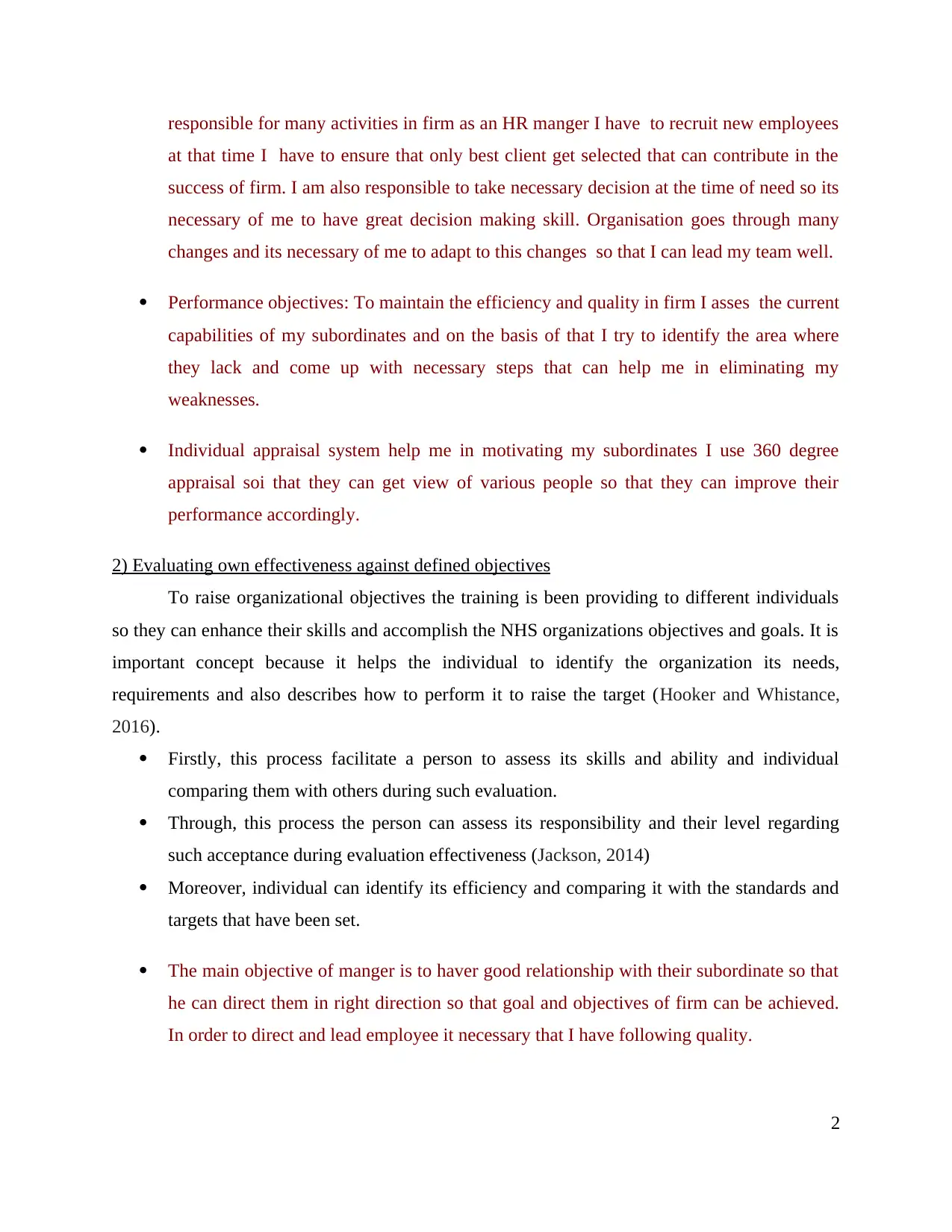
responsible for many activities in firm as an HR manger I have to recruit new employees
at that time I have to ensure that only best client get selected that can contribute in the
success of firm. I am also responsible to take necessary decision at the time of need so its
necessary of me to have great decision making skill. Organisation goes through many
changes and its necessary of me to adapt to this changes so that I can lead my team well.
Performance objectives: To maintain the efficiency and quality in firm I asses the current
capabilities of my subordinates and on the basis of that I try to identify the area where
they lack and come up with necessary steps that can help me in eliminating my
weaknesses.
Individual appraisal system help me in motivating my subordinates I use 360 degree
appraisal soi that they can get view of various people so that they can improve their
performance accordingly.
2) Evaluating own effectiveness against defined objectives
To raise organizational objectives the training is been providing to different individuals
so they can enhance their skills and accomplish the NHS organizations objectives and goals. It is
important concept because it helps the individual to identify the organization its needs,
requirements and also describes how to perform it to raise the target (Hooker and Whistance,
2016).
Firstly, this process facilitate a person to assess its skills and ability and individual
comparing them with others during such evaluation.
Through, this process the person can assess its responsibility and their level regarding
such acceptance during evaluation effectiveness (Jackson, 2014)
Moreover, individual can identify its efficiency and comparing it with the standards and
targets that have been set.
The main objective of manger is to haver good relationship with their subordinate so that
he can direct them in right direction so that goal and objectives of firm can be achieved.
In order to direct and lead employee it necessary that I have following quality.
2
at that time I have to ensure that only best client get selected that can contribute in the
success of firm. I am also responsible to take necessary decision at the time of need so its
necessary of me to have great decision making skill. Organisation goes through many
changes and its necessary of me to adapt to this changes so that I can lead my team well.
Performance objectives: To maintain the efficiency and quality in firm I asses the current
capabilities of my subordinates and on the basis of that I try to identify the area where
they lack and come up with necessary steps that can help me in eliminating my
weaknesses.
Individual appraisal system help me in motivating my subordinates I use 360 degree
appraisal soi that they can get view of various people so that they can improve their
performance accordingly.
2) Evaluating own effectiveness against defined objectives
To raise organizational objectives the training is been providing to different individuals
so they can enhance their skills and accomplish the NHS organizations objectives and goals. It is
important concept because it helps the individual to identify the organization its needs,
requirements and also describes how to perform it to raise the target (Hooker and Whistance,
2016).
Firstly, this process facilitate a person to assess its skills and ability and individual
comparing them with others during such evaluation.
Through, this process the person can assess its responsibility and their level regarding
such acceptance during evaluation effectiveness (Jackson, 2014)
Moreover, individual can identify its efficiency and comparing it with the standards and
targets that have been set.
The main objective of manger is to haver good relationship with their subordinate so that
he can direct them in right direction so that goal and objectives of firm can be achieved.
In order to direct and lead employee it necessary that I have following quality.
2
Paraphrase This Document
Need a fresh take? Get an instant paraphrase of this document with our AI Paraphraser
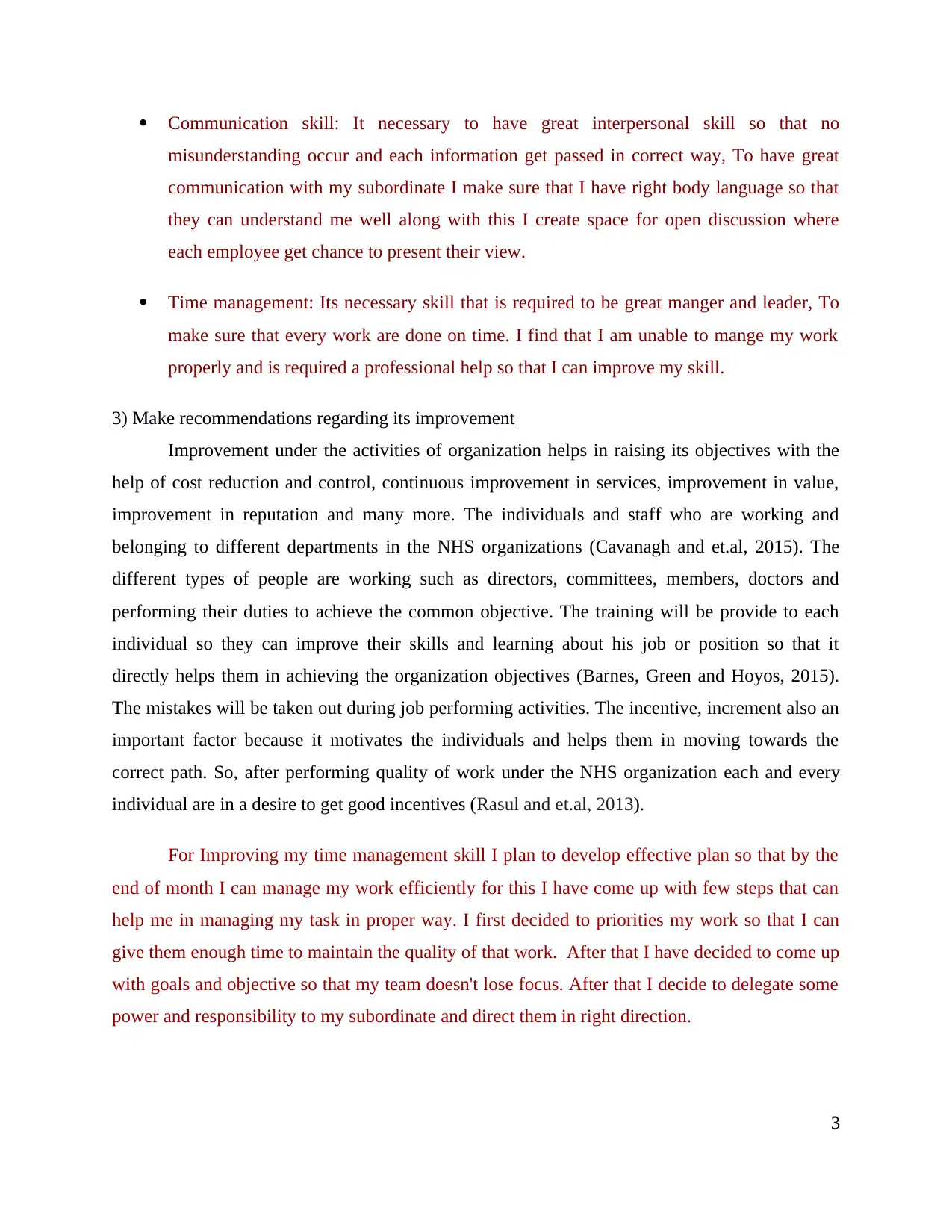
Communication skill: It necessary to have great interpersonal skill so that no
misunderstanding occur and each information get passed in correct way, To have great
communication with my subordinate I make sure that I have right body language so that
they can understand me well along with this I create space for open discussion where
each employee get chance to present their view.
Time management: Its necessary skill that is required to be great manger and leader, To
make sure that every work are done on time. I find that I am unable to mange my work
properly and is required a professional help so that I can improve my skill.
3) Make recommendations regarding its improvement
Improvement under the activities of organization helps in raising its objectives with the
help of cost reduction and control, continuous improvement in services, improvement in value,
improvement in reputation and many more. The individuals and staff who are working and
belonging to different departments in the NHS organizations (Cavanagh and et.al, 2015). The
different types of people are working such as directors, committees, members, doctors and
performing their duties to achieve the common objective. The training will be provide to each
individual so they can improve their skills and learning about his job or position so that it
directly helps them in achieving the organization objectives (Barnes, Green and Hoyos, 2015).
The mistakes will be taken out during job performing activities. The incentive, increment also an
important factor because it motivates the individuals and helps them in moving towards the
correct path. So, after performing quality of work under the NHS organization each and every
individual are in a desire to get good incentives (Rasul and et.al, 2013).
For Improving my time management skill I plan to develop effective plan so that by the
end of month I can manage my work efficiently for this I have come up with few steps that can
help me in managing my task in proper way. I first decided to priorities my work so that I can
give them enough time to maintain the quality of that work. After that I have decided to come up
with goals and objective so that my team doesn't lose focus. After that I decide to delegate some
power and responsibility to my subordinate and direct them in right direction.
3
misunderstanding occur and each information get passed in correct way, To have great
communication with my subordinate I make sure that I have right body language so that
they can understand me well along with this I create space for open discussion where
each employee get chance to present their view.
Time management: Its necessary skill that is required to be great manger and leader, To
make sure that every work are done on time. I find that I am unable to mange my work
properly and is required a professional help so that I can improve my skill.
3) Make recommendations regarding its improvement
Improvement under the activities of organization helps in raising its objectives with the
help of cost reduction and control, continuous improvement in services, improvement in value,
improvement in reputation and many more. The individuals and staff who are working and
belonging to different departments in the NHS organizations (Cavanagh and et.al, 2015). The
different types of people are working such as directors, committees, members, doctors and
performing their duties to achieve the common objective. The training will be provide to each
individual so they can improve their skills and learning about his job or position so that it
directly helps them in achieving the organization objectives (Barnes, Green and Hoyos, 2015).
The mistakes will be taken out during job performing activities. The incentive, increment also an
important factor because it motivates the individuals and helps them in moving towards the
correct path. So, after performing quality of work under the NHS organization each and every
individual are in a desire to get good incentives (Rasul and et.al, 2013).
For Improving my time management skill I plan to develop effective plan so that by the
end of month I can manage my work efficiently for this I have come up with few steps that can
help me in managing my task in proper way. I first decided to priorities my work so that I can
give them enough time to maintain the quality of that work. After that I have decided to come up
with goals and objective so that my team doesn't lose focus. After that I decide to delegate some
power and responsibility to my subordinate and direct them in right direction.
3
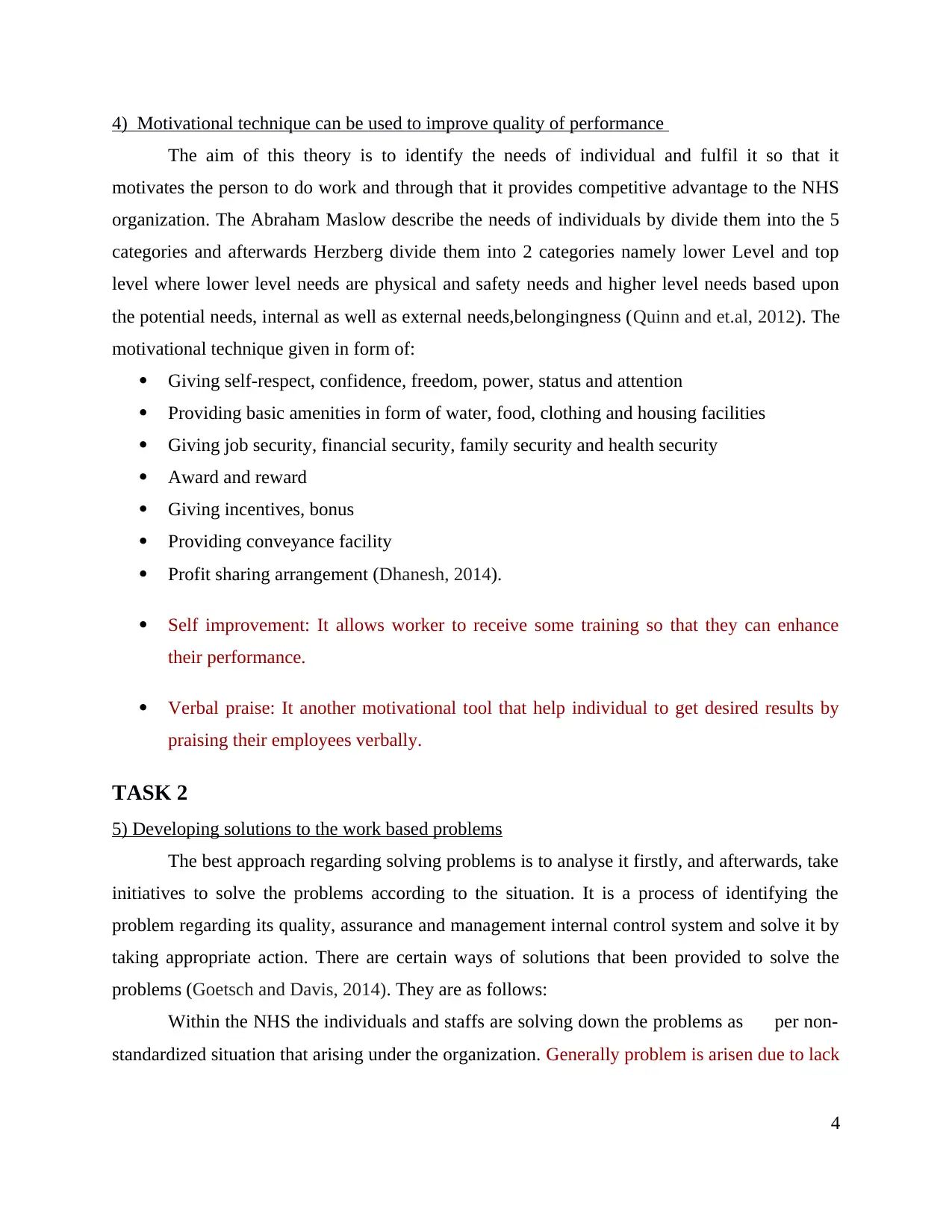
4) Motivational technique can be used to improve quality of performance
The aim of this theory is to identify the needs of individual and fulfil it so that it
motivates the person to do work and through that it provides competitive advantage to the NHS
organization. The Abraham Maslow describe the needs of individuals by divide them into the 5
categories and afterwards Herzberg divide them into 2 categories namely lower Level and top
level where lower level needs are physical and safety needs and higher level needs based upon
the potential needs, internal as well as external needs,belongingness (Quinn and et.al, 2012). The
motivational technique given in form of:
Giving self-respect, confidence, freedom, power, status and attention
Providing basic amenities in form of water, food, clothing and housing facilities
Giving job security, financial security, family security and health security
Award and reward
Giving incentives, bonus
Providing conveyance facility
Profit sharing arrangement (Dhanesh, 2014).
Self improvement: It allows worker to receive some training so that they can enhance
their performance.
Verbal praise: It another motivational tool that help individual to get desired results by
praising their employees verbally.
TASK 2
5) Developing solutions to the work based problems
The best approach regarding solving problems is to analyse it firstly, and afterwards, take
initiatives to solve the problems according to the situation. It is a process of identifying the
problem regarding its quality, assurance and management internal control system and solve it by
taking appropriate action. There are certain ways of solutions that been provided to solve the
problems (Goetsch and Davis, 2014). They are as follows:
Within the NHS the individuals and staffs are solving down the problems as per non-
standardized situation that arising under the organization. Generally problem is arisen due to lack
4
The aim of this theory is to identify the needs of individual and fulfil it so that it
motivates the person to do work and through that it provides competitive advantage to the NHS
organization. The Abraham Maslow describe the needs of individuals by divide them into the 5
categories and afterwards Herzberg divide them into 2 categories namely lower Level and top
level where lower level needs are physical and safety needs and higher level needs based upon
the potential needs, internal as well as external needs,belongingness (Quinn and et.al, 2012). The
motivational technique given in form of:
Giving self-respect, confidence, freedom, power, status and attention
Providing basic amenities in form of water, food, clothing and housing facilities
Giving job security, financial security, family security and health security
Award and reward
Giving incentives, bonus
Providing conveyance facility
Profit sharing arrangement (Dhanesh, 2014).
Self improvement: It allows worker to receive some training so that they can enhance
their performance.
Verbal praise: It another motivational tool that help individual to get desired results by
praising their employees verbally.
TASK 2
5) Developing solutions to the work based problems
The best approach regarding solving problems is to analyse it firstly, and afterwards, take
initiatives to solve the problems according to the situation. It is a process of identifying the
problem regarding its quality, assurance and management internal control system and solve it by
taking appropriate action. There are certain ways of solutions that been provided to solve the
problems (Goetsch and Davis, 2014). They are as follows:
Within the NHS the individuals and staffs are solving down the problems as per non-
standardized situation that arising under the organization. Generally problem is arisen due to lack
4
⊘ This is a preview!⊘
Do you want full access?
Subscribe today to unlock all pages.

Trusted by 1+ million students worldwide
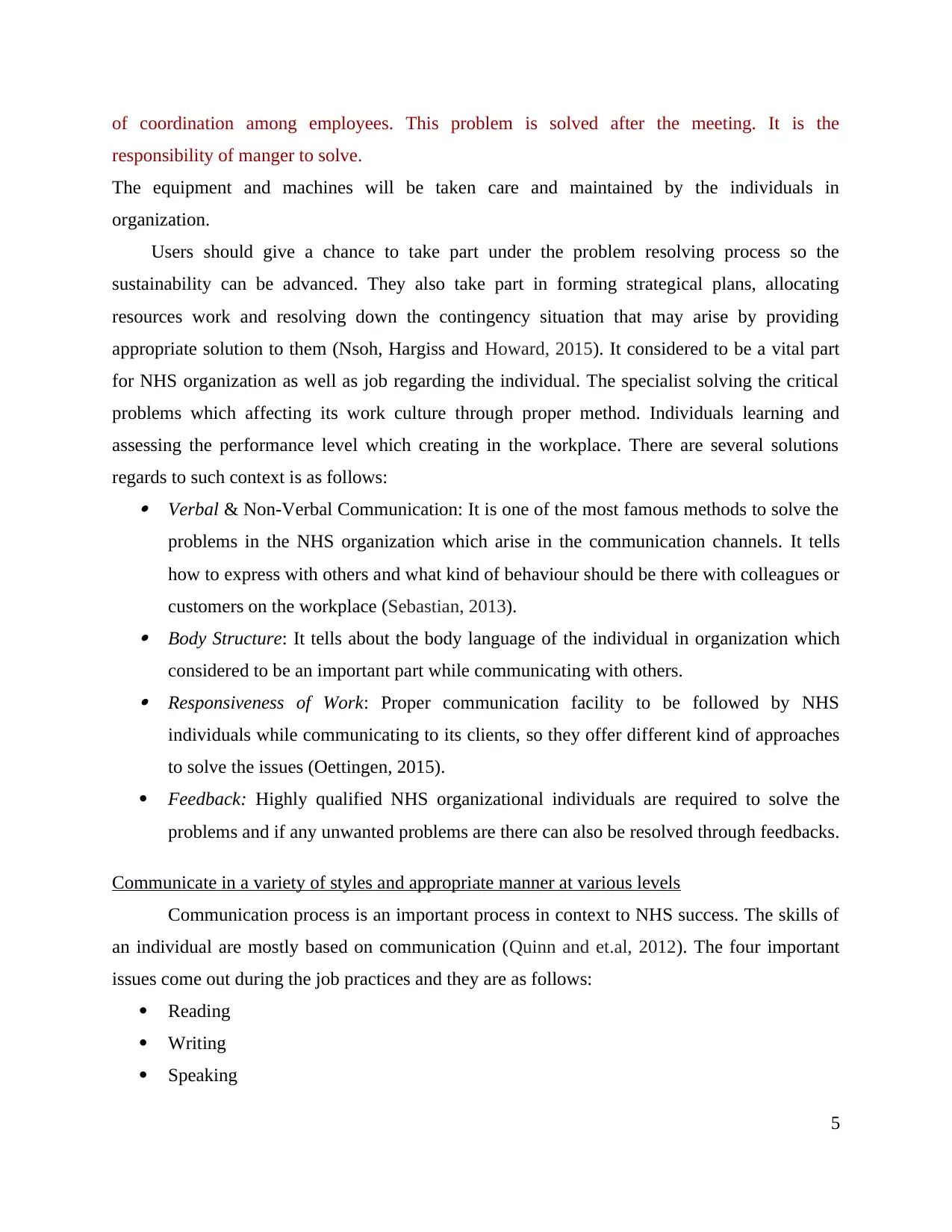
of coordination among employees. This problem is solved after the meeting. It is the
responsibility of manger to solve.
The equipment and machines will be taken care and maintained by the individuals in
organization.
Users should give a chance to take part under the problem resolving process so the
sustainability can be advanced. They also take part in forming strategical plans, allocating
resources work and resolving down the contingency situation that may arise by providing
appropriate solution to them (Nsoh, Hargiss and Howard, 2015). It considered to be a vital part
for NHS organization as well as job regarding the individual. The specialist solving the critical
problems which affecting its work culture through proper method. Individuals learning and
assessing the performance level which creating in the workplace. There are several solutions
regards to such context is as follows: Verbal & Non-Verbal Communication: It is one of the most famous methods to solve the
problems in the NHS organization which arise in the communication channels. It tells
how to express with others and what kind of behaviour should be there with colleagues or
customers on the workplace (Sebastian, 2013). Body Structure: It tells about the body language of the individual in organization which
considered to be an important part while communicating with others. Responsiveness of Work: Proper communication facility to be followed by NHS
individuals while communicating to its clients, so they offer different kind of approaches
to solve the issues (Oettingen, 2015).
Feedback: Highly qualified NHS organizational individuals are required to solve the
problems and if any unwanted problems are there can also be resolved through feedbacks.
Communicate in a variety of styles and appropriate manner at various levels
Communication process is an important process in context to NHS success. The skills of
an individual are mostly based on communication (Quinn and et.al, 2012). The four important
issues come out during the job practices and they are as follows:
Reading
Writing
Speaking
5
responsibility of manger to solve.
The equipment and machines will be taken care and maintained by the individuals in
organization.
Users should give a chance to take part under the problem resolving process so the
sustainability can be advanced. They also take part in forming strategical plans, allocating
resources work and resolving down the contingency situation that may arise by providing
appropriate solution to them (Nsoh, Hargiss and Howard, 2015). It considered to be a vital part
for NHS organization as well as job regarding the individual. The specialist solving the critical
problems which affecting its work culture through proper method. Individuals learning and
assessing the performance level which creating in the workplace. There are several solutions
regards to such context is as follows: Verbal & Non-Verbal Communication: It is one of the most famous methods to solve the
problems in the NHS organization which arise in the communication channels. It tells
how to express with others and what kind of behaviour should be there with colleagues or
customers on the workplace (Sebastian, 2013). Body Structure: It tells about the body language of the individual in organization which
considered to be an important part while communicating with others. Responsiveness of Work: Proper communication facility to be followed by NHS
individuals while communicating to its clients, so they offer different kind of approaches
to solve the issues (Oettingen, 2015).
Feedback: Highly qualified NHS organizational individuals are required to solve the
problems and if any unwanted problems are there can also be resolved through feedbacks.
Communicate in a variety of styles and appropriate manner at various levels
Communication process is an important process in context to NHS success. The skills of
an individual are mostly based on communication (Quinn and et.al, 2012). The four important
issues come out during the job practices and they are as follows:
Reading
Writing
Speaking
5
Paraphrase This Document
Need a fresh take? Get an instant paraphrase of this document with our AI Paraphraser

Listening
So, to make the communication process effective one should be good reader, writer,
speaker and listener. In this modern world technology playing a vital role in the communications
channels when it following from top to lower or vice versa. The first issue arise under the
communication process is that in case of employability work and to check the skills regarding it,
the technology may not playing a definite role but instead of that communication playing an
efficient role under workplace to improve the skills of an individual (Rasul and et.al, 2013).
Another issue coming out the communication process is English Language. It is most preferable
language which is used in the communication so, people should have good command and skill
so, they able to communicate easily with another. Basically, it is not a simple task to
communicate properly at all the levels because at some stages the outcomes may not be possible.
So, one has to adopt it properly and settle the problems to raise the objective. By, using the
appropriate communication the working person within the organization communicate it with
users, patients by giving message and wishing them on occasions by using proper
communication and providing various services with that regard (Miller, Biggart and Newton,
2013).
Identify effective time management strategies
Time management process is an effective tool in the National Health Services
Organisation. To make the employability skills efficient and effective, time management process
plays an important part and it is to be required compulsorily. Time management should be there
under functions and role which playing by organizational individuals while performing its duties
and also developing the skills of the person and make them effective (Dhanesh, 2014). The time
which is using for performing activity is according to the time or not, it can only be identified by
using such time management strategies. Time management strategies helping down NHS
organization so their work will not go beyond of time. Time management is the main process in
which employees has to manage things within the given time period time management show the
efficiency level of the employees. It helps to enhance the quality of the management team as
well. The time management strategies are as follows:
Giving priority to the task and the task which is more important for organization point of
view will be carrying out firstly (Goetsch and Davis, 2014).
6
So, to make the communication process effective one should be good reader, writer,
speaker and listener. In this modern world technology playing a vital role in the communications
channels when it following from top to lower or vice versa. The first issue arise under the
communication process is that in case of employability work and to check the skills regarding it,
the technology may not playing a definite role but instead of that communication playing an
efficient role under workplace to improve the skills of an individual (Rasul and et.al, 2013).
Another issue coming out the communication process is English Language. It is most preferable
language which is used in the communication so, people should have good command and skill
so, they able to communicate easily with another. Basically, it is not a simple task to
communicate properly at all the levels because at some stages the outcomes may not be possible.
So, one has to adopt it properly and settle the problems to raise the objective. By, using the
appropriate communication the working person within the organization communicate it with
users, patients by giving message and wishing them on occasions by using proper
communication and providing various services with that regard (Miller, Biggart and Newton,
2013).
Identify effective time management strategies
Time management process is an effective tool in the National Health Services
Organisation. To make the employability skills efficient and effective, time management process
plays an important part and it is to be required compulsorily. Time management should be there
under functions and role which playing by organizational individuals while performing its duties
and also developing the skills of the person and make them effective (Dhanesh, 2014). The time
which is using for performing activity is according to the time or not, it can only be identified by
using such time management strategies. Time management strategies helping down NHS
organization so their work will not go beyond of time. Time management is the main process in
which employees has to manage things within the given time period time management show the
efficiency level of the employees. It helps to enhance the quality of the management team as
well. The time management strategies are as follows:
Giving priority to the task and the task which is more important for organization point of
view will be carrying out firstly (Goetsch and Davis, 2014).
6
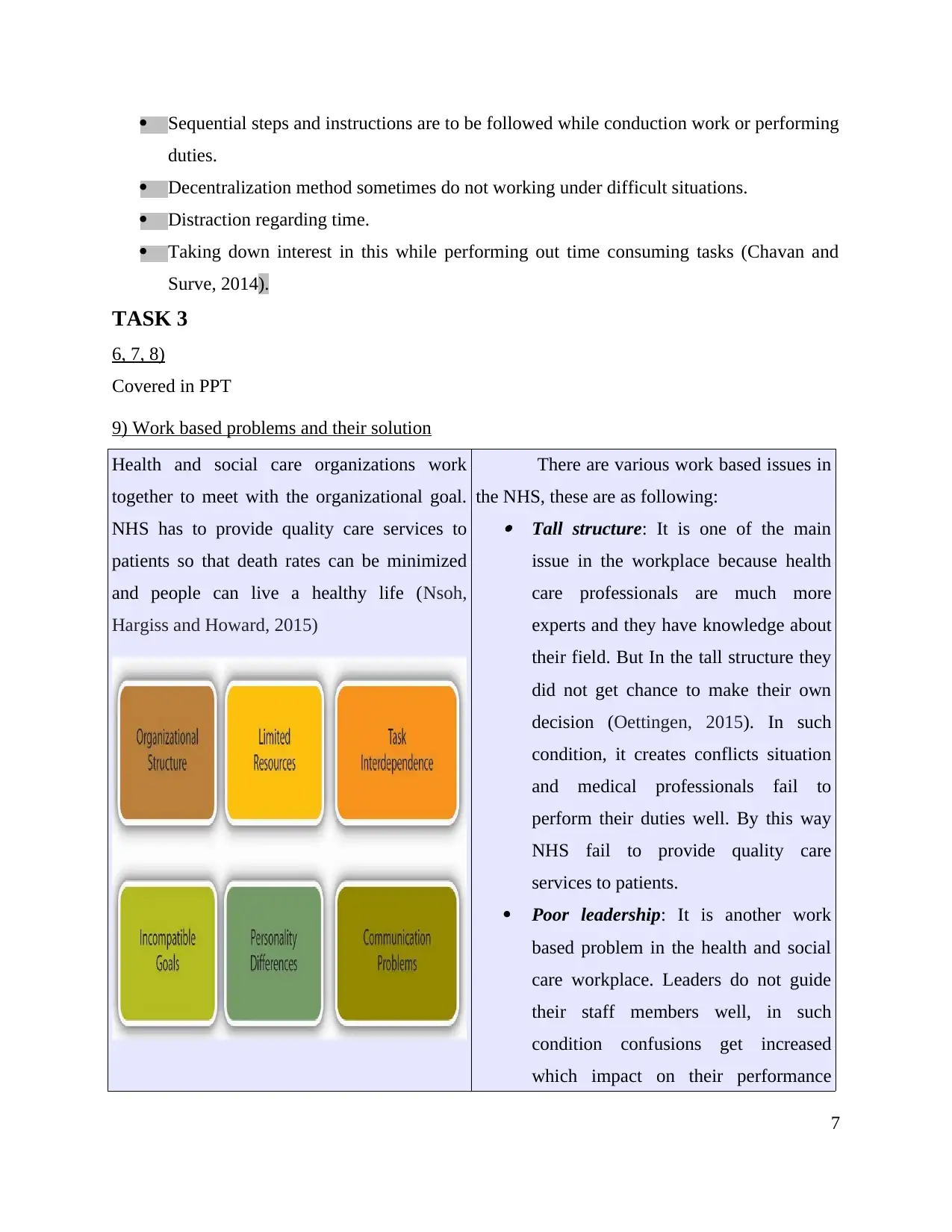
Sequential steps and instructions are to be followed while conduction work or performing
duties.
Decentralization method sometimes do not working under difficult situations.
Distraction regarding time.
Taking down interest in this while performing out time consuming tasks (Chavan and
Surve, 2014).
TASK 3
6, 7, 8)
Covered in PPT
9) Work based problems and their solution
Health and social care organizations work
together to meet with the organizational goal.
NHS has to provide quality care services to
patients so that death rates can be minimized
and people can live a healthy life (Nsoh,
Hargiss and Howard, 2015)
There are various work based issues in
the NHS, these are as following:
Tall structure: It is one of the main
issue in the workplace because health
care professionals are much more
experts and they have knowledge about
their field. But In the tall structure they
did not get chance to make their own
decision (Oettingen, 2015). In such
condition, it creates conflicts situation
and medical professionals fail to
perform their duties well. By this way
NHS fail to provide quality care
services to patients.
Poor leadership: It is another work
based problem in the health and social
care workplace. Leaders do not guide
their staff members well, in such
condition confusions get increased
which impact on their performance
7
duties.
Decentralization method sometimes do not working under difficult situations.
Distraction regarding time.
Taking down interest in this while performing out time consuming tasks (Chavan and
Surve, 2014).
TASK 3
6, 7, 8)
Covered in PPT
9) Work based problems and their solution
Health and social care organizations work
together to meet with the organizational goal.
NHS has to provide quality care services to
patients so that death rates can be minimized
and people can live a healthy life (Nsoh,
Hargiss and Howard, 2015)
There are various work based issues in
the NHS, these are as following:
Tall structure: It is one of the main
issue in the workplace because health
care professionals are much more
experts and they have knowledge about
their field. But In the tall structure they
did not get chance to make their own
decision (Oettingen, 2015). In such
condition, it creates conflicts situation
and medical professionals fail to
perform their duties well. By this way
NHS fail to provide quality care
services to patients.
Poor leadership: It is another work
based problem in the health and social
care workplace. Leaders do not guide
their staff members well, in such
condition confusions get increased
which impact on their performance
7
⊘ This is a preview!⊘
Do you want full access?
Subscribe today to unlock all pages.

Trusted by 1+ million students worldwide
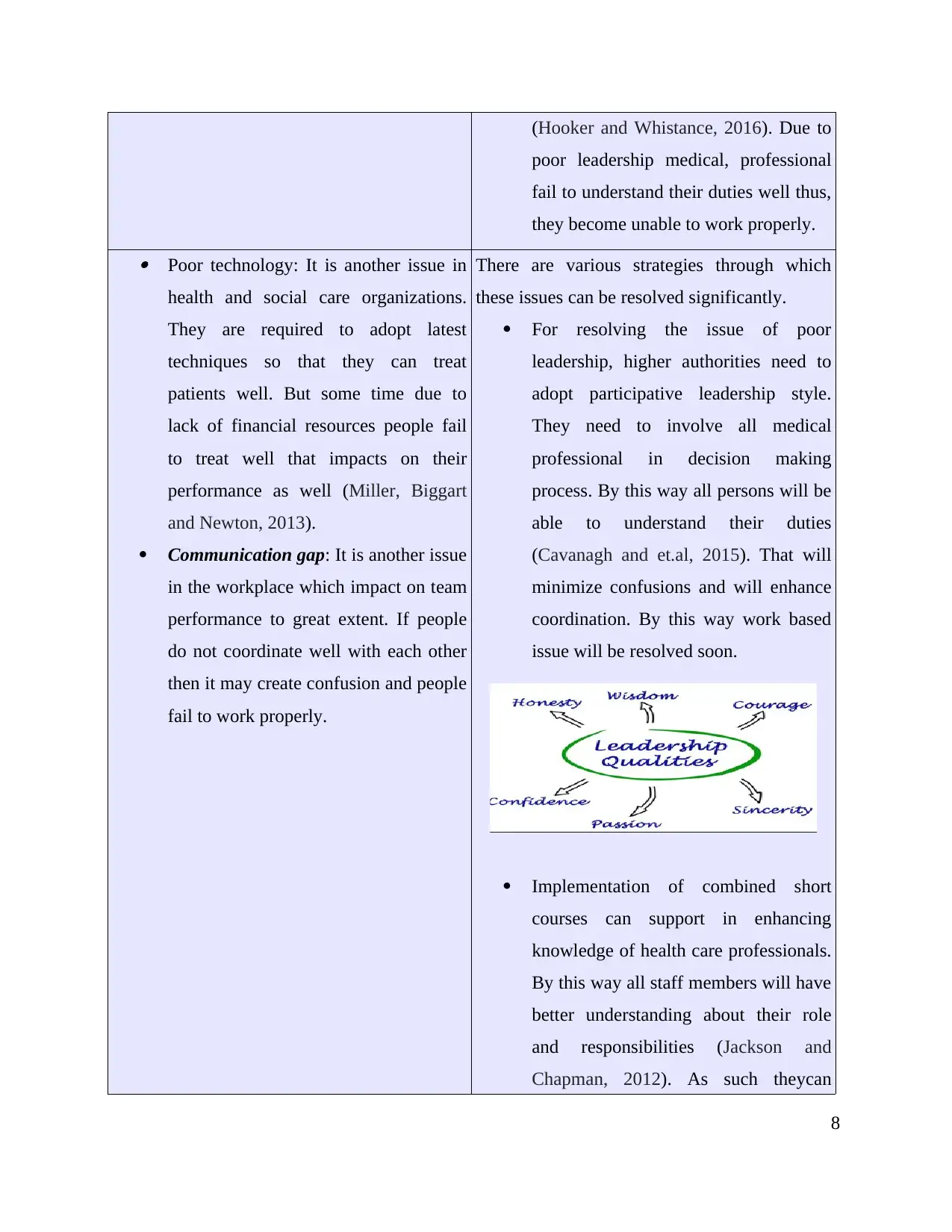
(Hooker and Whistance, 2016). Due to
poor leadership medical, professional
fail to understand their duties well thus,
they become unable to work properly. Poor technology: It is another issue in
health and social care organizations.
They are required to adopt latest
techniques so that they can treat
patients well. But some time due to
lack of financial resources people fail
to treat well that impacts on their
performance as well (Miller, Biggart
and Newton, 2013).
Communication gap: It is another issue
in the workplace which impact on team
performance to great extent. If people
do not coordinate well with each other
then it may create confusion and people
fail to work properly.
There are various strategies through which
these issues can be resolved significantly.
For resolving the issue of poor
leadership, higher authorities need to
adopt participative leadership style.
They need to involve all medical
professional in decision making
process. By this way all persons will be
able to understand their duties
(Cavanagh and et.al, 2015). That will
minimize confusions and will enhance
coordination. By this way work based
issue will be resolved soon.
Implementation of combined short
courses can support in enhancing
knowledge of health care professionals.
By this way all staff members will have
better understanding about their role
and responsibilities (Jackson and
Chapman, 2012). As such theycan
8
poor leadership medical, professional
fail to understand their duties well thus,
they become unable to work properly. Poor technology: It is another issue in
health and social care organizations.
They are required to adopt latest
techniques so that they can treat
patients well. But some time due to
lack of financial resources people fail
to treat well that impacts on their
performance as well (Miller, Biggart
and Newton, 2013).
Communication gap: It is another issue
in the workplace which impact on team
performance to great extent. If people
do not coordinate well with each other
then it may create confusion and people
fail to work properly.
There are various strategies through which
these issues can be resolved significantly.
For resolving the issue of poor
leadership, higher authorities need to
adopt participative leadership style.
They need to involve all medical
professional in decision making
process. By this way all persons will be
able to understand their duties
(Cavanagh and et.al, 2015). That will
minimize confusions and will enhance
coordination. By this way work based
issue will be resolved soon.
Implementation of combined short
courses can support in enhancing
knowledge of health care professionals.
By this way all staff members will have
better understanding about their role
and responsibilities (Jackson and
Chapman, 2012). As such theycan
8
Paraphrase This Document
Need a fresh take? Get an instant paraphrase of this document with our AI Paraphraser
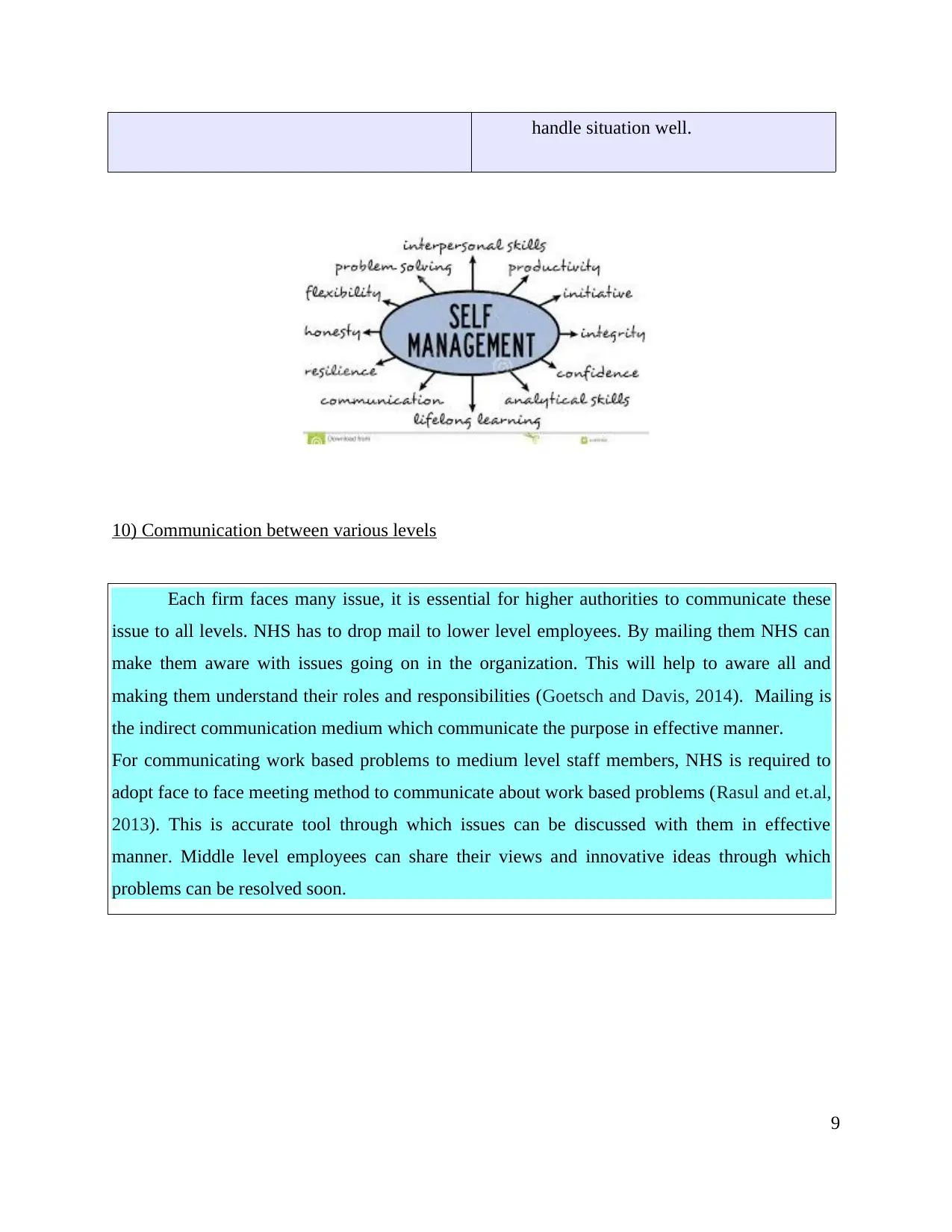
handle situation well.
10) Communication between various levels
Each firm faces many issue, it is essential for higher authorities to communicate these
issue to all levels. NHS has to drop mail to lower level employees. By mailing them NHS can
make them aware with issues going on in the organization. This will help to aware all and
making them understand their roles and responsibilities (Goetsch and Davis, 2014). Mailing is
the indirect communication medium which communicate the purpose in effective manner.
For communicating work based problems to medium level staff members, NHS is required to
adopt face to face meeting method to communicate about work based problems (Rasul and et.al,
2013). This is accurate tool through which issues can be discussed with them in effective
manner. Middle level employees can share their views and innovative ideas through which
problems can be resolved soon.
9
10) Communication between various levels
Each firm faces many issue, it is essential for higher authorities to communicate these
issue to all levels. NHS has to drop mail to lower level employees. By mailing them NHS can
make them aware with issues going on in the organization. This will help to aware all and
making them understand their roles and responsibilities (Goetsch and Davis, 2014). Mailing is
the indirect communication medium which communicate the purpose in effective manner.
For communicating work based problems to medium level staff members, NHS is required to
adopt face to face meeting method to communicate about work based problems (Rasul and et.al,
2013). This is accurate tool through which issues can be discussed with them in effective
manner. Middle level employees can share their views and innovative ideas through which
problems can be resolved soon.
9
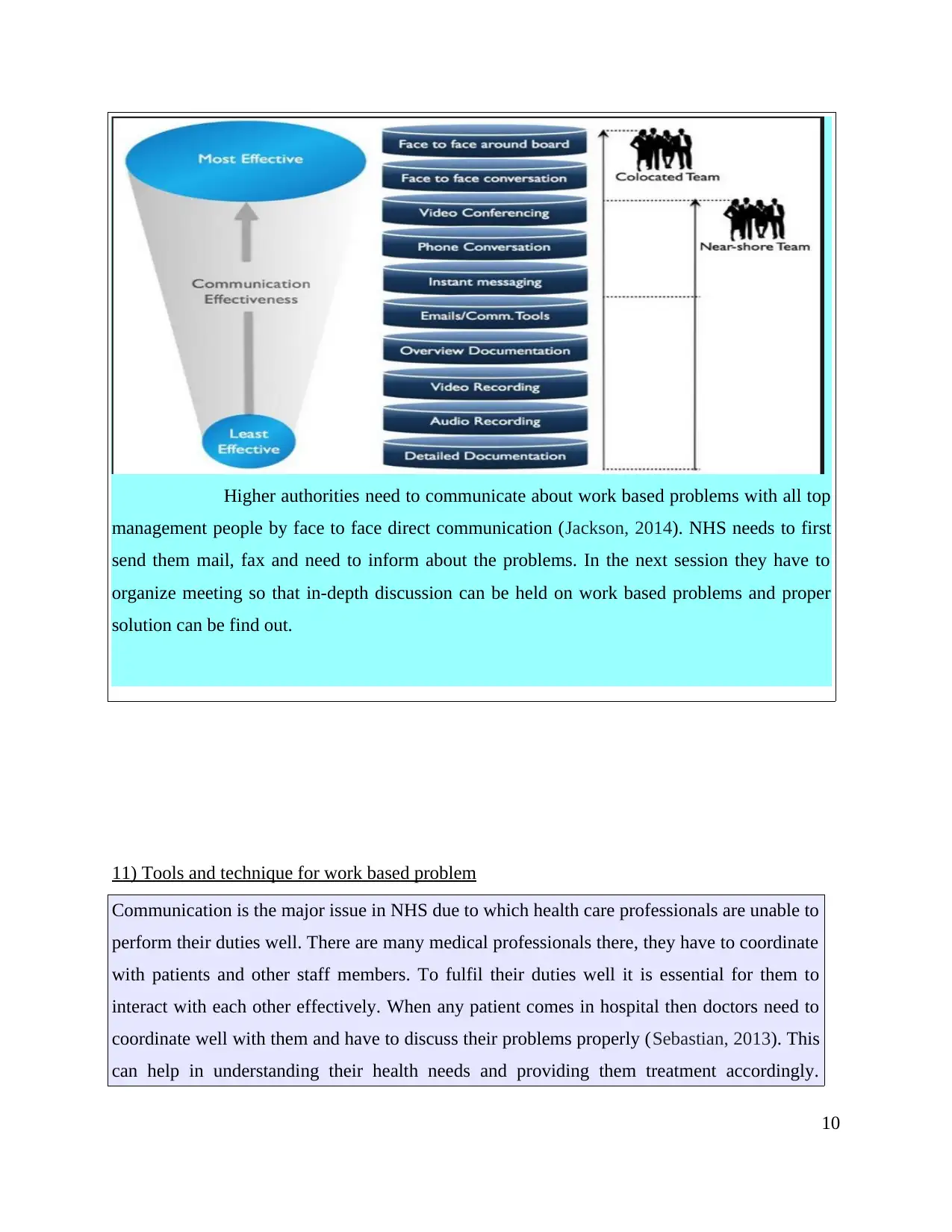
Higher authorities need to communicate about work based problems with all top
management people by face to face direct communication (Jackson, 2014). NHS needs to first
send them mail, fax and need to inform about the problems. In the next session they have to
organize meeting so that in-depth discussion can be held on work based problems and proper
solution can be find out.
11) Tools and technique for work based problem
Communication is the major issue in NHS due to which health care professionals are unable to
perform their duties well. There are many medical professionals there, they have to coordinate
with patients and other staff members. To fulfil their duties well it is essential for them to
interact with each other effectively. When any patient comes in hospital then doctors need to
coordinate well with them and have to discuss their problems properly (Sebastian, 2013). This
can help in understanding their health needs and providing them treatment accordingly.
10
management people by face to face direct communication (Jackson, 2014). NHS needs to first
send them mail, fax and need to inform about the problems. In the next session they have to
organize meeting so that in-depth discussion can be held on work based problems and proper
solution can be find out.
11) Tools and technique for work based problem
Communication is the major issue in NHS due to which health care professionals are unable to
perform their duties well. There are many medical professionals there, they have to coordinate
with patients and other staff members. To fulfil their duties well it is essential for them to
interact with each other effectively. When any patient comes in hospital then doctors need to
coordinate well with them and have to discuss their problems properly (Sebastian, 2013). This
can help in understanding their health needs and providing them treatment accordingly.
10
⊘ This is a preview!⊘
Do you want full access?
Subscribe today to unlock all pages.

Trusted by 1+ million students worldwide
1 out of 16
Related Documents
Your All-in-One AI-Powered Toolkit for Academic Success.
+13062052269
info@desklib.com
Available 24*7 on WhatsApp / Email
![[object Object]](/_next/static/media/star-bottom.7253800d.svg)
Unlock your academic potential
Copyright © 2020–2025 A2Z Services. All Rights Reserved. Developed and managed by ZUCOL.





